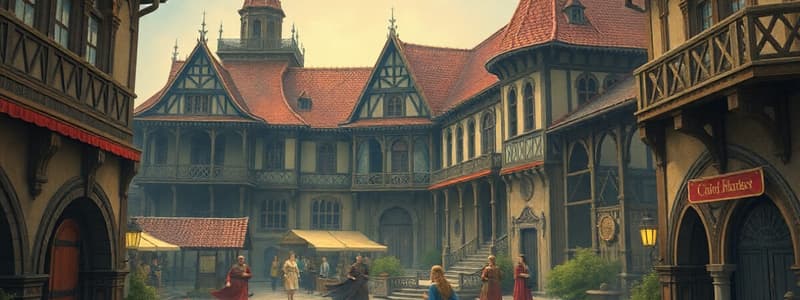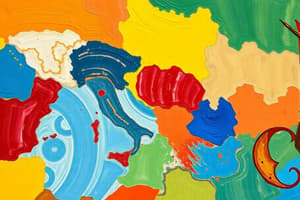Podcast
Questions and Answers
What political structure began with the Roman Empire and later led to feudalism in Western Europe?
What political structure began with the Roman Empire and later led to feudalism in Western Europe?
- Absolute monarchy
- Decentralized political organization (correct)
- Democratic governance
- Theocracy
What event in 476 CE marked the beginning of the Middle Ages in Western Europe?
What event in 476 CE marked the beginning of the Middle Ages in Western Europe?
- The rise of the Catholic Church
- The fall of the Western Roman Empire (correct)
- The establishment of the Byzantine Empire
- The initiation of the Crusades
Which term describes the traditional view of the Church’s authority in Western Europe during the Middle Ages?
Which term describes the traditional view of the Church’s authority in Western Europe during the Middle Ages?
- Divine right (correct)
- Meritocracy
- Secularism
- Democratic representation
What significant shift in power occurred in Western Europe during the Late Middle Ages?
What significant shift in power occurred in Western Europe during the Late Middle Ages?
Which Christian denomination dominated Eastern Europe and had a different governance system from the Western Church?
Which Christian denomination dominated Eastern Europe and had a different governance system from the Western Church?
How did the Crusades impact the relationship between the Eastern Orthodox Church and the Catholic Church?
How did the Crusades impact the relationship between the Eastern Orthodox Church and the Catholic Church?
What was the primary role of the Church in the social structure of Western Europe during the Middle Ages?
What was the primary role of the Church in the social structure of Western Europe during the Middle Ages?
Which of the following statements accurately reflects women's roles in Western Europe during the Middle Ages?
Which of the following statements accurately reflects women's roles in Western Europe during the Middle Ages?
What was a consequence of the Black Death on the social structure in Western Europe?
What was a consequence of the Black Death on the social structure in Western Europe?
How did the cultural developments in Eastern Europe differ from those in Western Europe during the Middle Ages?
How did the cultural developments in Eastern Europe differ from those in Western Europe during the Middle Ages?
Flashcards
Roman Empire's Centralization
Roman Empire's Centralization
The Roman Empire was ruled by a single centralized government with one leader controlling all territories. The Empire transitioned from a Republic to an empire with an Emperor.
Feudalism
Feudalism
A decentralized political system based on land ownership and loyalty. Kings granted land (fiefs) to lords, who in turn granted land to knights and peasants, creating a hierarchy of loyalty.
Byzantine Empire
Byzantine Empire
The Eastern Roman Empire, located in Constantinople, preserved Roman traditions and continued with a central government and organized bureaucracy. It was the successor to the Roman Empire.
Kievan-Rus
Kievan-Rus
Signup and view all the flashcards
Great Schism of Christianity
Great Schism of Christianity
Signup and view all the flashcards
Feudalism's Structure
Feudalism's Structure
Signup and view all the flashcards
Why did the Roman Empire split?
Why did the Roman Empire split?
Signup and view all the flashcards
What happened to the Western Roman Empire?
What happened to the Western Roman Empire?
Signup and view all the flashcards
Byzantine Empire's Legacy
Byzantine Empire's Legacy
Signup and view all the flashcards
What is Caesaropapism?
What is Caesaropapism?
Signup and view all the flashcards
What was the Great Schism?
What was the Great Schism?
Signup and view all the flashcards
What is the significance of the Crusades?
What is the significance of the Crusades?
Signup and view all the flashcards
Why did the Church become so powerful in Western Europe?
Why did the Church become so powerful in Western Europe?
Signup and view all the flashcards
What is Humanism?
What is Humanism?
Signup and view all the flashcards
What were the social structures of Western Europe?
What were the social structures of Western Europe?
Signup and view all the flashcards
Study Notes
European Developments (1.6)
- Political Traditions: The Roman Empire initially unified much of Europe under a single ruler. Later divisions into Western and Eastern empires led to religious and cultural differences.
- Western Europe: The fall of the Western Roman Empire (476 CE) ushered in the Middle Ages, characterized by feudalism. Kings granted land (fiefs) to lords, who in turn provided military service. Lords granted land to knights, who fought for them, and peasants farmed the land for protection. Eventually, monarchs consolidated power, taxing populations and becoming less dependent on nobles. France, England, and the Holy Roman Empire dominated.
- Eastern Europe: The Byzantine Empire, successor to the Roman East, maintained a centralized government in Constantinople. Russia emerged from independent city-states, notably Kievan Rus', which adopted Orthodox Christianity. Close ties formed with the Byzantine Empire.
- Religious Traditions: The Great Schism of 1054 CE divided Christianity into Roman Catholicism (Western Europe) and Eastern Orthodoxy. The Roman Catholic Church, led by the Pope, held significant power and influence in a politically fragmented region. Eastern Orthodoxy followed a "Caesaropapism" model, where the emperor was both head of state and the church. The Crusades, holy wars, had a lasting impact on European relations with other regions and caused further divisions.
- Cultural Traditions: The Church dominated Western European culture and education. The Renaissance, beginning in the 14th century, brought renewed interest in classical Greek and Roman knowledge, ideas, and works. Humanism focused on individuals and the world. The printing press expanded literacy and vernacular languages. This period marks a shift away from feudal systems and toward more modernized approaches. The Eastern European region maintained diverse cultures connected under a single empire.
- Social Traditions: Western European society was rigid and highly structured by the feudal system and followed patriarchal principles. Women held limited rights and opportunities in this society. Women had limited rights and fewer opportunities. Eastern European society offered greater opportunities to women in terms of property ownership and inheritance, though their involvement in the public sphere was limited.
Studying That Suits You
Use AI to generate personalized quizzes and flashcards to suit your learning preferences.




